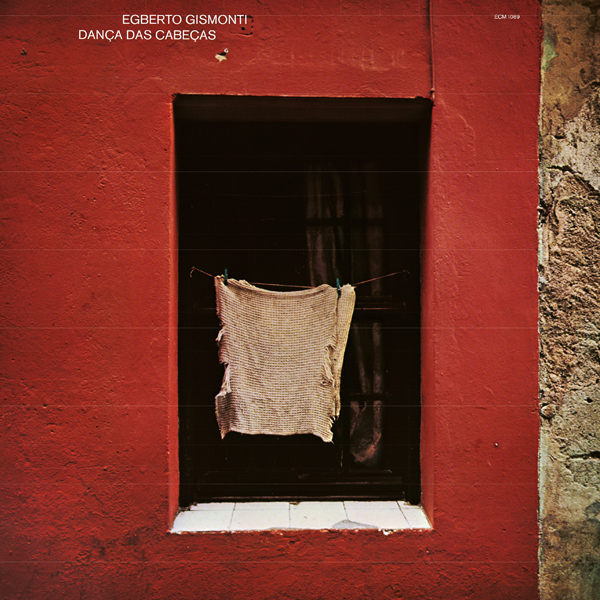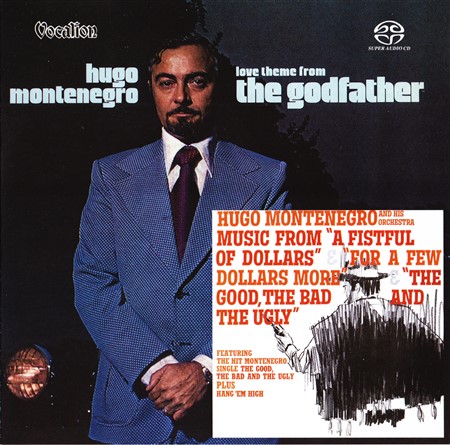
Egberto Gismonti – Danca Das Cabecas (1977/2016)
FLAC (tracks) 24 bit/192 kHz | Time – 49:59 minutes | 1,6 GB | Genre: Jazz
Studio Masters, Official Digital Download – Source: Qobuz | Booklet, Front Cover | © ECM Records
Recorded: November 1976 at Talent Studio, Oslo
Egberto Gismonti’s first ECM appearance is also his most understated. Dança das Cabeças (Dance of the Heads) was to be a solo album, due to the fact that the Brazilian government had inflated travel expenses for he and his band to the questionable figure of 7000 dollars a head. Gismonti was the only among them able to make the journey, but as fate would have it, he met Nana Vasconcelos quite by accident while in Norway to prepare for this recording. According to Alvaro Neder, when Vasconcelos asked him to describe the concept behind this project, Gismonti told him it was “the history of two boys wandering through a dense, humid forest, full of insects and animals, keeping a 180-feet distance from each other.” It was a history the two musicians shared without articulation, and Vasconcelos immediately agreed to join, thereby bringing another visionary into the label’s fold.
“It sounds just like a rain forest!” Perhaps you have heard this assessment being made in reference to many a New-Age album, sporting lush trees on its cover and layered within with preprogrammed synthesizers and wooden flutes. Dança, by contrast, is as far as one can get from the contrived exotica that haunt our commercial soundscapes. We are fully situated in the acoustic benefits of live musicianship, captured in all their immediacy in ECM’s standard-setting clarity. And so, while the birdlike sounds of Part I do indeed evoke a forest practically dripping with fecundity, it is populated with more than a few brightly colored animals. Like Marion Brown’s Afternoon Of A Georgia Faun, its sound is as deliberate as it is organic. From these canopied beginnings, we get some jangly strums from Gismonti’s guitar, slaloming between frenzied hand drums. Rhythms and melodies build to infectious heights, diving into our blood with every fluted moment. The musicians raise their cries, from which Gismonti spins a free-flowing grace, as if to trace lines of varying distance in a vast topographic map. Vasconcelos returns in all his fullness with drums, maracas, and shakers, while Gismonti’s fingers move on in their quiet persistence. Changes in syncopation and a few helpings of dissonant harmonies enact a skeleton dance of sorts, soaring resolutely into the music’s ritual heart. Gismonti’s classical training shines through in Part II, for which he puts his fingers to keys in a spacious and revelatory stroll through Keith Jarrett territory. From this heartwarming nostalgia, built in arcs with only the occasional angles, Gismonti morphs into a bellowed vocalise and storm of handclaps. He returns to the guitar before closing with another pianistic statement in improvised space.
This remains the Brazilian multi-instrumentalist’s most direct effort. In it, we find him without masks. It is the kind of music that makes one glad to be alive, a breath of clarity in polluted air. Essential for anyone who appreciates what music can bring to the heart, mind, and body.
This reissue of the album recorded in 1977 is a landmark of the careers of Gismonti and percussionist Naná Vasconcelos, his only accompanist here. Recorded in only three days, the album’s concept is based on the history shared by both musicians, according to Gismonti: two boys wandering through a dense, humid forest, full of insects and animals, keeping a 180-feet distance from each other. The album received several international awards, in England, U.S., Germany, and Brazil. It also, changed both artist’s lives: Naná immediately became a disputed international artist, touring worldwide; Egberto returned to Brazil, decided to research Amazon folklore, which would be reflected in his later work. The music is pure and sensitive, challenging and sophisticated, with a broad dynamic range going from haunting, mysterious melodies to full-impact, energetic percussive sounds reminiscent of Brazilian Indians’ batuque. Attention for the re-creation of “Fé Cega, Faca Amolada” (Milton Nascimento/Ronaldo Bastos), foretold with a motif several minutes before the presentation of the integral piece. -AllMusic Review by Alvaro Neder
Tracklist:
1. Dança Das Cabeças, Pt. 1 25:25
— Quarto Mundo #1
— Dança Das Cabeças
— Aguas Luminosas
— Celebração De Núpcias
— Porta Encantada
— Quarto Mundo #2
2. Dança Das Cabeças, Pt. 2 24:34
— Tango
— Bambuzal
— Fé Cega Faca Amolada
— Dança Solitária
Personnel:
Egberto Gismonti, 8-string guitar, piano, wood flutes, voice
Naná Vasconcelos, percussion, berimbau, corpo, voice
Download:
mqs.link_EgbertGismntiDanaDasCabeas19772016Qbuz24192.part1.rar
mqs.link_EgbertGismntiDanaDasCabeas19772016Qbuz24192.part2.rar




















![Egberto Gismonti - Sol Do Meio Dia (1978/2023) [FLAC 24bit/96kHz] Egberto Gismonti - Sol Do Meio Dia (1978/2023) [FLAC 24bit/96kHz]](https://imghd.xyz/images/2023/09/03/j5pxt1tlmxqdb_600.jpg)
![Jan Garbarek, Egberto Gismonti, Charlie Haden - Magico: Carta de Amor (2012) [HDTracks FLAC 24bit/48kHz] Jan Garbarek, Egberto Gismonti, Charlie Haden - Magico: Carta de Amor (2012) [HDTracks FLAC 24bit/48kHz]](https://getimg.link/images/imgimgimg/uploads/2016/04/7B2Rg22.jpg)
![Ricardo Villalobos, Max Loderbauer - Re: ECM (2011) [Qobuz FLAC 24bit/44,1kHz] Ricardo Villalobos, Max Loderbauer - Re: ECM (2011) [Qobuz FLAC 24bit/44,1kHz]](https://getimg.link/images/imgimgimg/uploads/2018/04/dM2ZvVE.jpg)

![Ferenc Snetberger - In Concert (2016) [Qobuz FLAC 24bit/96kHz] Ferenc Snetberger - In Concert (2016) [Qobuz FLAC 24bit/96kHz]](https://getimg.link/images/imgimgimg/uploads/2018/09/ztc6bDc.jpg)
![Ornette Coleman - The Atlantic Years (2018) [AcousticSounds FLAC 24bit/192kHz] Ornette Coleman - The Atlantic Years (2018) [AcousticSounds FLAC 24bit/192kHz]](https://getimg.link/images/imgimgimg/uploads/2018/11/2ZFbQJs.jpg)
![Dominic Miller - Silent Light (2017) [HighResAudio FLAC 24bit/96kHz] Dominic Miller - Silent Light (2017) [HighResAudio FLAC 24bit/96kHz]](https://getimg.link/images/imgimgimg/uploads/2018/02/r8a1VbQ.jpg)
![Arild Andersen - Celebration (2012) [Qobuz FLAC 24bit/48kHz] Arild Andersen - Celebration (2012) [Qobuz FLAC 24bit/48kHz]](https://getimg.link/images/imgimgimg/uploads/2018/01/9YEpImv.jpg)
![Ralph Towner, Wolfgang Muthspiel, Slava Grigoryan - Travel Guide (2013) [Qobuz FLAC 24bit/88,2kHz] Ralph Towner, Wolfgang Muthspiel, Slava Grigoryan - Travel Guide (2013) [Qobuz FLAC 24bit/88,2kHz]](https://getimg.link/images/imgimgimg/uploads/2016/08/gbmbQ3M.jpg)
![Mathias Eick - Skala (2011) [Qobuz FLAC 24bit/96kHz] Mathias Eick - Skala (2011) [Qobuz FLAC 24bit/96kHz]](https://getimg.link/images/imgimgimg/uploads/2018/03/37nq7Y5.jpg)
![Olivier Benoit, Orchestre National de Jazz - Europa: Oslo (2017) [Qobuz 24-44,1] Olivier Benoit, Orchestre National de Jazz - Europa: Oslo (2017) [Qobuz 24-44,1]](https://getimg.link/images/imgimgimg/uploads/2017/10/IroTCfD.jpg)
![Eddie Daniels & Harlem Quartet - Heart of Brazil (2019) [HighResAudio FLAC 24bit/192kHz] Eddie Daniels & Harlem Quartet - Heart of Brazil (2019) [HighResAudio FLAC 24bit/192kHz]](https://getimg.link/images/imgimgimg/uploads/2019/12/QNd9Oy5.jpg)
![Thomas Stronen, Iain Ballamy (Food) - Mercurial Balm (2012) [Qobuz FLAC 24bit/96kHz] Thomas Stronen, Iain Ballamy (Food) - Mercurial Balm (2012) [Qobuz FLAC 24bit/96kHz]](https://getimg.link/images/imgimgimg/uploads/2019/07/8ABFJul.jpg)
![Thomas Stronen, Iain Ballamy (Food) - Mercurial Balm (2012) [Qobuz FLAC 24bit/96kHz] Thomas Stronen, Iain Ballamy (Food) - Mercurial Balm (2012) [Qobuz FLAC 24bit/96kHz]](https://getimg.link/images/imgimgimg/uploads/2018/09/8ABFJul.jpg)
![Nigel Price Organ Trio - Heads & Tales, Vol. 2 (2016) [HDTracks FLAC 24bit/44,1kHz] Nigel Price Organ Trio - Heads & Tales, Vol. 2 (2016) [HDTracks FLAC 24bit/44,1kHz]](https://getimg.link/images/imgimgimg/uploads/2018/11/84C2Yir.jpg)